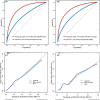ANAID-ICH nomogram for predicting unfavorable outcome after intracerebral hemorrhage
- PMID: 36000537
- PMCID: PMC9627367
- DOI: 10.1111/cns.13941
ANAID-ICH nomogram for predicting unfavorable outcome after intracerebral hemorrhage
Abstract
Objective: Diffusion-weighted imaging lesions (DWILs) are associated with unfavorable outcome in intracerebral hemorrhage (ICH). We proposed a novel predictive nomogram incorporating DWILs.
Methods: A total of 738 patients with primary ICH in a tertiary hospital were prospectively enrolled as a training cohort. DWILs were defined as remote focal hyperintensities on DWI corresponding to low intensities on apparent diffusion coefficient images and remote from the focal hematoma. The outcome of interest was modified Rankin Scale scores of 4-6 at 90 days after onset. Multivariate logistic regression was used to construct a nomogram. Model performance was tested in the training cohort and externally validated with respect to discrimination, calibration, and clinical usefulness in another institute. Additionally, the nomogram was compared with the ICH score in terms of predictive ability.
Results: Overall, 153 (20.73%) and 23 (15.54%) patients developed an unfavorable outcome in the training and validation cohorts, respectively. The multivariate analysis revealed that age, National Institutes of Health Stroke Scale (NIHSS) score, anemia, infratentorial location, presence of DWILs, and prior ICH were associated with unfavorable outcome. Our ANAID-ICH nomogram was constructed according to the aforementioned variables; the area under the receiver operating characteristic curve was 0.842 and 0.831 in the training and validation sets, respectively. With regard to the 90-day outcome, the nomogram showed a significantly higher predictive value than the ICH score in both cohorts.
Conclusions: The ANAID-ICH nomogram comprising age, NIHSS score, anemia, infratentorial location, presence of DWILs, and prior ICH may facilitate the identification of patients at higher risk for an unfavorable outcome.
Keywords: cerebral hemorrhage; magnetic resonance imaging; nomogram; prognosis.
© 2022 The Authors. CNS Neuroscience & Therapeutics published by John Wiley & Sons Ltd.
Conflict of interest statement
None.
Figures





Similar articles
-
Nomogram Models for Predicting Poor Prognosis in Lobar Intracerebral Hemorrhage: A Multicenter Study.Curr Neurovasc Res. 2025;21(5):595-605. doi: 10.2174/0115672026365579241220073506. Curr Neurovasc Res. 2025. PMID: 39757632
-
A prognostic nomogram incorporating red cell distribution width for patients with intracerebral hemorrhage.Medicine (Baltimore). 2020 Dec 11;99(50):e23557. doi: 10.1097/MD.0000000000023557. Medicine (Baltimore). 2020. PMID: 33327308 Free PMC article.
-
Predictive Nomogram for Unfavorable Outcome of Spontaneous Intracerebral Hemorrhage.World Neurosurg. 2022 Aug;164:e1111-e1122. doi: 10.1016/j.wneu.2022.05.111. Epub 2022 May 30. World Neurosurg. 2022. PMID: 35654327 Review.
-
Early elevated neutrophil-to-lymphocyte ratio associated with remote diffusion-weighted imaging lesions in acute intracerebral hemorrhage.CNS Neurosci Ther. 2020 Apr;26(4):430-437. doi: 10.1111/cns.13249. Epub 2019 Oct 25. CNS Neurosci Ther. 2020. PMID: 31651093 Free PMC article.
-
Development and Validation of a Prediction Model for 30-Day Mortality and Functional Outcome in Patients with Primary Brainstem Hemorrhage.Cerebrovasc Dis. 2024;53(1):79-87. doi: 10.1159/000530348. Epub 2023 May 25. Cerebrovasc Dis. 2024. PMID: 37231825 Review.
Cited by
-
Development and validation of a machine learning-based predictive model for assessing the 90-day prognostic outcome of patients with spontaneous intracerebral hemorrhage.J Transl Med. 2024 Mar 4;22(1):236. doi: 10.1186/s12967-024-04896-3. J Transl Med. 2024. PMID: 38439097 Free PMC article.
-
Risk Factors for Early Poor Outcomes in In-hospital Intracranial Hemorrhage: A Retrospective Cohort Study.Neurocrit Care. 2025 Jul 1. doi: 10.1007/s12028-025-02306-0. Online ahead of print. Neurocrit Care. 2025. PMID: 40593295
-
Doctor, what is my risk of bleeding after cardiac surgery while on combined anticoagulant with antiplatelet therapy? A validated nomogram for risk assessment.Front Pharmacol. 2025 Jan 7;15:1528390. doi: 10.3389/fphar.2024.1528390. eCollection 2024. Front Pharmacol. 2025. PMID: 39840117 Free PMC article.
-
Machine learning prediction of motor function in chronic stroke patients: a systematic review and meta-analysis.Front Neurol. 2023 Jun 13;14:1039794. doi: 10.3389/fneur.2023.1039794. eCollection 2023. Front Neurol. 2023. PMID: 37388543 Free PMC article.
-
Development and validation of a novel clinical prediction model to predict the 90-day functional outcome of spontaneous intracerebral hemorrhage.Front Neurol. 2023 Sep 26;14:1260104. doi: 10.3389/fneur.2023.1260104. eCollection 2023. Front Neurol. 2023. PMID: 37830093 Free PMC article.
References
-
- Cordonnier C, Demchuk A, Ziai W, Anderson CS. Intracerebral haemorrhage: current approaches to acute management. Lancet. 2018;392(10154):1257‐1268. - PubMed
-
- van Asch CJ, Luitse MJ, Rinkel GJ, van der Tweel I, Algra A, Klijn CJ. Incidence, case fatality, and functional outcome of intracerebral haemorrhage over time, according to age, sex, and ethnic origin: a systematic review and meta‐analysis. Lancet Neurol. 2010;9(2):167‐176. - PubMed
-
- Hemphill JC, Bonovich DC, Besmertis L, Manley GT, Johnston SC. The ICH score: a simple, reliable grading scale for intracerebral hemorrhage. Stroke. 2001;32(4):891‐897. - PubMed
-
- Gregório T, Pipa S, Cavaleiro P, et al. Assessment and comparison of the four Most extensively validated prognostic scales for intracerebral hemorrhage: systematic review with meta‐analysis. Neurocrit Care. 2019;30(2):449‐466. - PubMed
Publication types
MeSH terms
LinkOut - more resources
Full Text Sources

